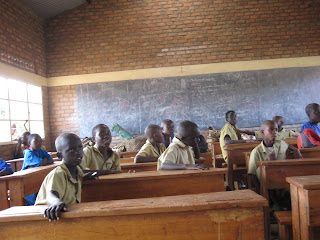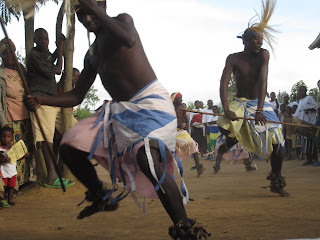After closing night for Goodness here in Kigali, I received an email from Michael Redhill. I had written to him about how the success, the impact of his play here made me feel that we had somehow failed, that I had not understood the value of what we brought, and had given it to too few. Since then, a first few steps have been made on making a reality of Michael's offer to give Goodness to Rwanda for a production in Kinyarwanda, free of rights (an idea that came to us from Kent Lawson, our NY-based supporter). This seems to me a good thing.
But after that closing night, Michael wrote me a wonderful email assuaging my initial doubts on what we had accomplished. I asked him if i could publish it, and he said yes. And it seems fitting that Michael Redhill should have the last word on this most remarkable of trips:
Dear Ross,
Don't be torn and don't wonder "what might have been" if more people had seen this play in Rwanda. If you'd even had one Rwandan tell you what so many have told you, Goodness would still have succeeded there beyond any of our aspirations. But seeing what is possible makes you hungry, understandably, and you'll have to whet that hunger somehow. That's one of the things, among many, that you are brilliant at.
But for now, I'll give you a Jewish prayer that will help. At Passover every year, we say "Dayenu" (pronounced "die-ay-NOO"). It's a narrative prayer that thanks God for fifteen gifts bestowed on the flight from Egypt and into Jerusalem. But in typical Jewish fashion—from this prayer one is convinced the Arameans were Yiddishkeit—it doesn't so much thank as it expresses relief that ANYTHING good happened. "Dayenu" means "it would have been enough for us"—so, at Passover we say "If God had lead us out of Egypt but not slain our oppressors, DAYENU. If God had slain our oppressors, but not destroyed their gods, DAYENU ..." You get the idea. I hope you realize how many dayenus there have been with this play. If it had had one good run and never gone to Edinburgh, DAYENU; if it had gone to Edinburgh and not won the biggest prize in the room, DAYENU—man, any of this would have been enough! But we've made a work of art that has gone well beyond success to something more ephemeral and rare, something not worth even wishing for. And you’ve all done it. This is a work of art that is more than merely good, it's transformative. Some of the only people on the planet who could tell you that have told you. We have changed their lives, and if it's only for one evening, then DAYENU.
Be of good cheer without any reservations, Ross, and tell the others as well. Goodness has not only led us out of Egypt, it also built a temple. Which is to say, in bringing even an atom of healing to people who have suffered as much as many of your audience members have, our work has been raised above the material and been made holy.
M
Don't be torn and don't wonder "what might have been" if more people had seen this play in Rwanda. If you'd even had one Rwandan tell you what so many have told you, Goodness would still have succeeded there beyond any of our aspirations. But seeing what is possible makes you hungry, understandably, and you'll have to whet that hunger somehow. That's one of the things, among many, that you are brilliant at.
But for now, I'll give you a Jewish prayer that will help. At Passover every year, we say "Dayenu" (pronounced "die-ay-NOO"). It's a narrative prayer that thanks God for fifteen gifts bestowed on the flight from Egypt and into Jerusalem. But in typical Jewish fashion—from this prayer one is convinced the Arameans were Yiddishkeit—it doesn't so much thank as it expresses relief that ANYTHING good happened. "Dayenu" means "it would have been enough for us"—so, at Passover we say "If God had lead us out of Egypt but not slain our oppressors, DAYENU. If God had slain our oppressors, but not destroyed their gods, DAYENU ..." You get the idea. I hope you realize how many dayenus there have been with this play. If it had had one good run and never gone to Edinburgh, DAYENU; if it had gone to Edinburgh and not won the biggest prize in the room, DAYENU—man, any of this would have been enough! But we've made a work of art that has gone well beyond success to something more ephemeral and rare, something not worth even wishing for. And you’ve all done it. This is a work of art that is more than merely good, it's transformative. Some of the only people on the planet who could tell you that have told you. We have changed their lives, and if it's only for one evening, then DAYENU.
Be of good cheer without any reservations, Ross, and tell the others as well. Goodness has not only led us out of Egypt, it also built a temple. Which is to say, in bringing even an atom of healing to people who have suffered as much as many of your audience members have, our work has been raised above the material and been made holy.
M





















































